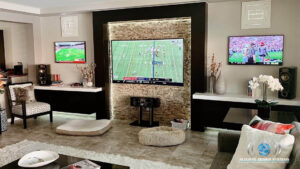Choosing a new TV for yourself or your family can be an overwhelming experience. With a variety of brands, sizes, resolutions, and features – the options are endless. But how do you know which one would be best for your room? It all depends on the room size, screen size, and features you want.
Location, Location, Location
Before heading to the store or browsing different TVs online, you’ll want to think about the room your TV will be going in, its general size, and where you’ll be installing the TV. For larger rooms like a family room, living room, entertainment room, media room, or den, you’ll want to look at TVs that are larger in size. For secondary rooms like bedrooms, kitchens, offices, and workout rooms, you’d want to look for something smaller, so they don’t take up too much space and overpower the room. Some rooms, whether large or small, may have space to fit a TV stand while others may require you to mount the TV on the wall.
Screen Size
While you may automatically want to pick the largest TV possible, you should take a few things into consideration such as the price, performance, living room space, and where you’ll be sitting in the room. For most homeowners, the ideal screen size is anywhere between 55 and 65 inches, and that’s for an “average” living room space of 12 x 18 feet. When it comes to where you’re sitting, you’ll want to be at a distance that is “three times more than the height of the screen for HD TVs and 1.5 times the screen height for 4K Ultra HD TVs,” according to Tom’s Guide. In layman’s terms, if you can see the individual pixels of the screen, you’re too close.
Features
Once you know the size of your room and how big of a screen you want, you’ll want to consider the features a TV can have. Three features to look at are the refresh rate, its viewing angle capabilities, and whether or not it’s ‘Smart’. There are two types of refresh rates for contemporary TVs – 60Hz and 120Hz. While TVs with a 60Hz refresh rate are typically more affordable, TVs with a 120Hz refresh rate offer higher-quality motion handling.
When looking at the viewing angle capabilities, you’ll want to figure out if the TV is OLED or LCD/LED. OLED TVs typically have a wider viewing angle than regular TVs, letting viewers that sit to the side see an image that is just as clear and dynamic as what the center seat sees.
Tired of wires taking up space behind your TV? Look for ones that are considered “Smart” and equipped with built-in internet connectivity. By getting a Smart TV, not only can you stream online content and access a range of regular TV channels, but they’ve got a graphical processing unit that enables them to display sharper and high-resolution images and videos.
Looking for a new TV is not as simple as one may think as there are a lot of factors and features to take into consideration. For more information on Smart TVs or to schedule a consultation with one of our System Designers and let us do the work for you, call or text us at 702-648-7474.




